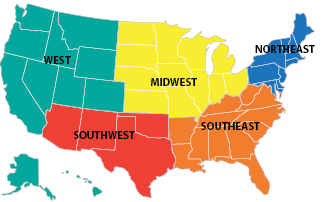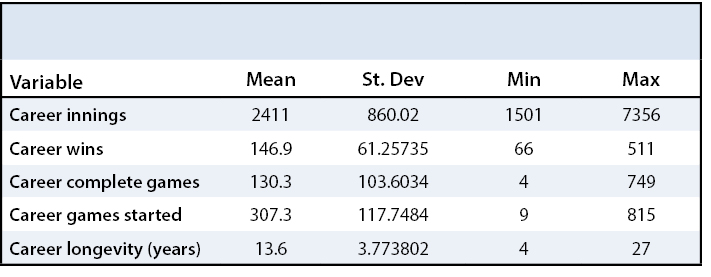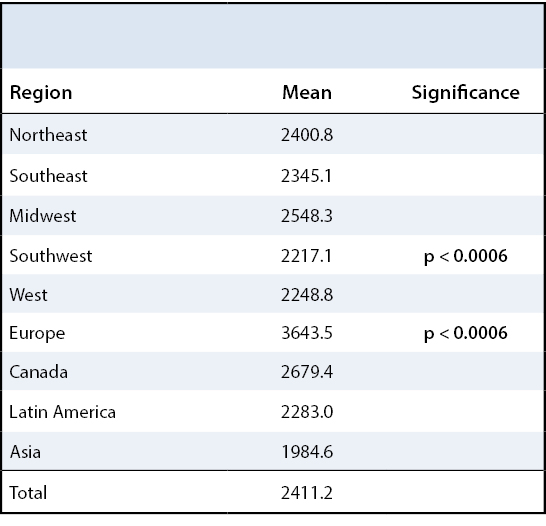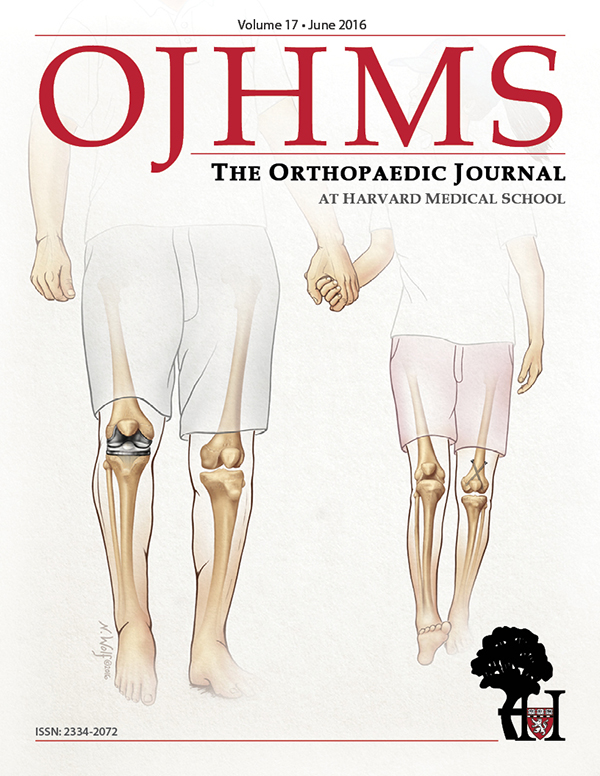Assessing the Impact of Youth Climate Differences in Elite Major League Baseball Pitchers
Gregory P. Kolovich, MD, David C. Flanigan, MD, Lorena Floccari, MD, Grant L. Jones, MD
The authors report no conflict of interest related to this work.
©2016 by The Orthopaedic Journal at Harvard Medical School
OBJECTIVE Recent studies demonstrate the detrimental effects on the glenohumeral joint by repetitive throwing at an early age in organized youth baseball. Pitchers born in warmer climates are afforded the opportunity to throw year-round, whereas pitchers born in colder climates are likely to take a break from throwing during the winter. We hypothesized that youth climate differences affect longevity of elite MLB pitchers.
METHODS Data were collected from all 710 MLB pitchers who compiled a minimum of 1,500 career innings. Forty pitchers were excluded from the study, as they were currently active on a MLB roster in 2011, bringing the total to 670 MLB pitchers. Four career pitching statistics were investigated: innings, wins, complete games, and games started.
RESULTS MLB pitchers born in regions with colder average temperatures (below 14 degrees Celsius) compiled an average of 187 more career innings (2497 versus 2310; p < 0.0049), had 13 more career wins (153 versus 140; p < 0.005), and had 49 more career complete games (153 versus 104; p < 0.001) than pitchers born in regions with warmer average temperatures (above 14 degrees Celsius). No statistically significant difference was found for career games started.
CONCLUSION MLB pitchers born in regions with colder average temperatures are more likely to take a break from throwing during the winter season. These colder-weather youth pitchers compiled greater career innings, career wins and career complete games, suggesting that pitching year-round at an early age may be detrimental to the longevity of Major League pitchers.
In Major League Baseball’s (MLB) 145-year history, only 24 pitchers have compiled 300 or more career victories, and only four have reached this milestone within the past 20 years.1,2 Regarding single season marks, 373 pitchers have compiled a minimum of 25 wins, and more than 600 pitchers have started 39 or more games, yet not one MLB pitcher has done so in 25 years.1,2 Posner et al. investigated MLB injuries from 2002-2008 and found pitchers to have a 34% higher injury risk than fielders.3 From 2000 to 2014, an average of 17.4 MLB pitchers per year had undergone ulnar collateral ligament reconstruction of the elbow (Tommy John surgery), peaking at 36 during the 2012 season.3,4
These trends have sparked debate regarding whether modern pitching longevity is diminishing. More than 140 peer-reviewed publications have demonstrated detrimental effects to the shoulder and elbow caused by excessive throwing in organized youth baseball.6-25 These ailments include proximal humeral epiphysiolysis, osteochondritis dissecans of the elbow, rotator cuff tendinitis, superior labrum from anterior to posterior (SLAP) tears and scapular dyskinesis, yet many are treated with structured stretching and rest from throwing.6-25
Young pitchers raised in warmer climates are afforded the opportunity to throw year-round, as opposed to pitchers raised in colder climates, where young pitchers are likely to take a break from throwing during the winter.4 Erikson et al. concluded that MLB pitchers who played high school baseball in warm weather climates have undergone medial UCL reconstruction more frequently and earlier than pitchers who played in cold weather areas.4 We hypothesized that pitchers born and raised in colder climates sustain less injury than youths raised in warmer climates, translating to longer careers. The purpose of this study was to investigate whether youth climate differences affect longevity of elite MLB pitchers.
Data were collected on all 710 MLB pitchers who compiled a minimum of 1,500 career innings.1 A minimum of 1,500 innings pitched was chosen because it is roughly one standard deviation above the MLB career average. Therefore, by excluding pitchers below this mark, only elite MLB pitchers with substantial careers were analyzed. Forty pitchers were currently active on a MLB roster during data collection.1 Because their career statistics were not yet finalized, each was excluded from analysis, bringing the total to 670 MLB pitchers. We investigated only career statistics associated with pitching longevity. While number of pitches is the definitive measure, historical data regarding career and season pitch counts are inaccessible or nonexistent.1 Moreover, career number of years seems an unfair measure, as relievers throw fewer pitches per season than starters, predisposing them to greater career years.1,3,26 We analyzed available data associated with the career mileage placed on a pitcher’s arm: career innings, career wins, career complete games, and career games started.
We investigated two groups of pitchers. Those born and raised in climates with an average temperature above 14 degrees Celsius (the current average global temperature) were defined as warm-weather pitchers and those raised in climates below were defined as cold-weather pitchers. Statistical data were obtained over a 138-year history (1876-2014) from an online baseball reference (www.baseball-reference.com).1 Youth climates were determined from demographical data available. If a pitcher relocated, bias was placed on the climate during the majority of the developmental years (ages 10-18).1
Pitchers were then stratified regionally in order to further investigate climate differences. Nine total regions were defined. The United States was divided into five regions: Northeast, Southeast, Midwest, Southwest and West, based on Figure 1. Canada, Asia, Europe and Latin America comprised the remaining four regions. Unpaired t-tests were used to determine differences between cold-weather pitchers and warm weather pitchers for each of the five statistical determinants of longevity.
ANOVA testing was performed to determine if career innings differed between regions. A p-value of < 0.05 was considered significant for all comparisons. All statistical analysis was performed using Stata/IC13 (Stata Corporation, College Station, TX).
Of all 670 inactive pitchers to compile a minimum of 1,500 career innings, the average MLB debut age was 22.1 years, and the average debut year was 1943. The majority of pitchers were right-handed (73%), from a colder climate (54%) and from Midwestern United States (30.0%). Only 9.7% were inducted into the Baseball Hall of Fame, and fewer than 6% were raised outside the United States. These demographics are summarized in Table 1. The average career spanned 13.1 years, while the average career innings and games started were 2,411 and 307, respectively. These results are summarized in Table 2.
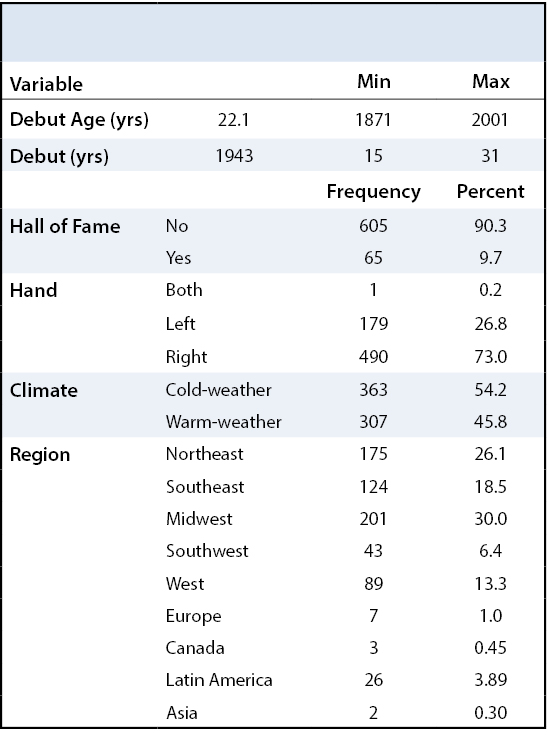
Analysis revealed significant differences between colder- and warmer-weather pitchers for the following statistics: career innings, career wins, and career complete games. MLB pitchers born in regions with colder average temperatures compiled 187 more career innings (2497 v. 2310 p < 0.0049), 13 more career wins (153 v. 140 p < 0.005), and 49 more career complete games (153 v. 140 p < 0.005). No statically significant differences were found when comparing career games started. These results suggest that MLB pitchers born in regions with colder average temperatures may have an advantage in terms of elite throwing longevity as evidenced by greater career innings, wins and complete games. No advantage was found for games started, as this was statistically equivalent between groups. These findings are demonstrated in Table 3. Further analysis revealed that career innings varied between pitchers born in different regions around the United States and world (p < 0.0006). The mean career innings for pitchers from Europe was the highest (3643.5) while those from Southwest United States (2217.1) and Asia (1984.6) were the smallest. Collectively, pitchers born in regions with colder average temperatures (Canada, Europe, Midwest US, and Northeast US) had greater mean career innings than pitchers born in regions with warmer average temperatures (Southeast US, Southwest US, West US, Latin America, and Asia). These results are demonstrated in Table 4.
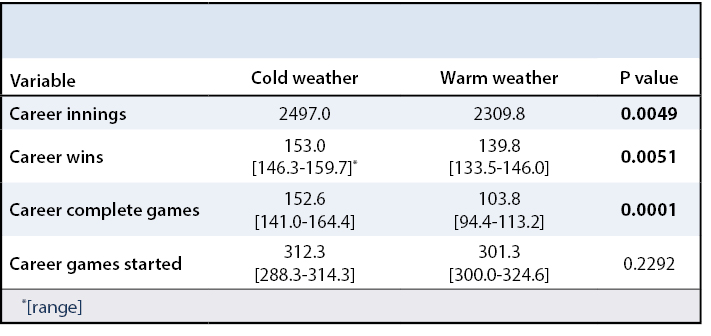
Unremitting and arduous demands on a pitcher’s throwing arm increase injury risk and jeopardize careers.3,26 Major League Baseball has become a multi-billion dollar industry, creating immense financial pressures to keep pitchers healthy and activated.1 Appearances on the disabled list (DL) are increasing with a greater proportion of disability days experienced by pitchers (62.4%) compared with fielders (37.6%).3
A pitcher’s throwing arm is subjected to distractive forces equivalent to the athlete’s body weight and angular velocities reaching 7,000 degrees per second.6,7 In 1953, Dotter was the first to describe a pattern of chronic stress fractures at the proximal humeral physis due to repetitive microtrauma and chronic stress overload in the adolescent thrower.8 He termed this epiphyiolysis Little Leaguer’s Shoulder. Since Dotter’s original description, numerous authors have described successful treatment algorithms involving monitored rest with a gradual return to throwing.9-12 Both Kocher and Carsen separately reported a 91% asymptomatic return to throwing after separate conservative regimens.12,13 In the late 1970s, research began to show that injury was secondary to poor mechanics.17,18 Slager concluded that a developing pitcher should first emphasize skills and control while Albright demonstrated that symptoms in youth pitchers correlated best with mechanics rather than age.14,15 Thirty years later, Davis et al. evaluated the mechanics of 169 adolescent (ages 14-18) and youth (ages 9-13) pitchers.16 They determined that adolescent pitchers performed essential biomechanic parameters of pitching more correctly leading to lower humeral torque, less valgus elbow load and better overall efficiency.
Carson and Gasser reviewed the largest series of Little Leaguer’s Shoulder (23 patients, average age 14) and discovered that 65% played year-round and 26% played on multiple teams.12 In 2006, Olsen et al. retrospectively compared 95 injured adolescent pitchers to a healthy cohort and determined that the injured group pitched 6 innings per appearance and 7.9 months per year on average.17 The uninjured group pitched an average of 4 innings per appearance and 5.5 months per year. They warned that pitchers were 4-5 times more likely to require surgery if a pitcher averaged 80 or more pitches per appearance or pitched more than 8 months per year and 36 times more likely to sustain injury when pitching in the setting of arm fatigue.17 The USA Baseball Medical and Safety Advisory Committee developed guidelines for youth pitcher safety in 2004, and in 2007 Little League Baseball replaced older recommendations of inning limits with pitch counts.27
The purpose of this study was to investigate whether climate differences during development affected a pitcher’s statistics associated with career longevity. Analyzing only established MLB pitchers who compiled a minimum of 1,500 career innings, our results demonstrate that pitchers raised in colder climates have greater career innings, wins and complete games. Regional stratification further demonstrates that pitchers who grew up in colder regions (Canada, Europe, Midwest US, and Northeast US) had greater career innings than pitchers raised in warmer regions (Southeast US, Southwest US, West US, Latin America, and Asia).
Several limitations must be noted in the interpretation of our findings. First, there is no way to objectively determine whether or not each pitcher refrained from throwing year-round during their development. Our hypothesis is contingent on the notion that cold weather pitchers are less likely to throw during winter months given the limiting temperatures and lack of baseball leagues. It is certainly possible that a cold weather pitcher threw year-round or a warm weather pitcher complied with offseason rest. These differences are likely to be insignificant given our large sample size and thus offer little confounding. Second, there are no established measures of pitching longevity. Pitch counts are the definitive measure but historical counts are inaccessible and could not be investigated.1,26 We therefore artificially defined longevity through available career pitching statistics and our definition may be subject to debate. Lastly, we did not investigate whether youth climate differences predispose pitchers to specific injuries. MLB pitching injuries are clearly defined, detailed and accessible for modern pitchers but not so historically, thus making a 145-year investigation extremely challenging. An examination of the impact of youth climate on subsequent pitching injury patterns is warranted for future collaborative research.
Our results suggest that MLB pitchers born in regions with colder average temperatures, who are more likely to break from throwing during the winter season, may have longer professional pitching careers as a result of less career arm injury and exhaustion. We suggest that pitching year round at an early age may be detrimental to the longevity of Major League pitchers. These findings support the need for continued pitch-count regulation in youth baseball and the need for monitored rest from throwing during the offseason.

